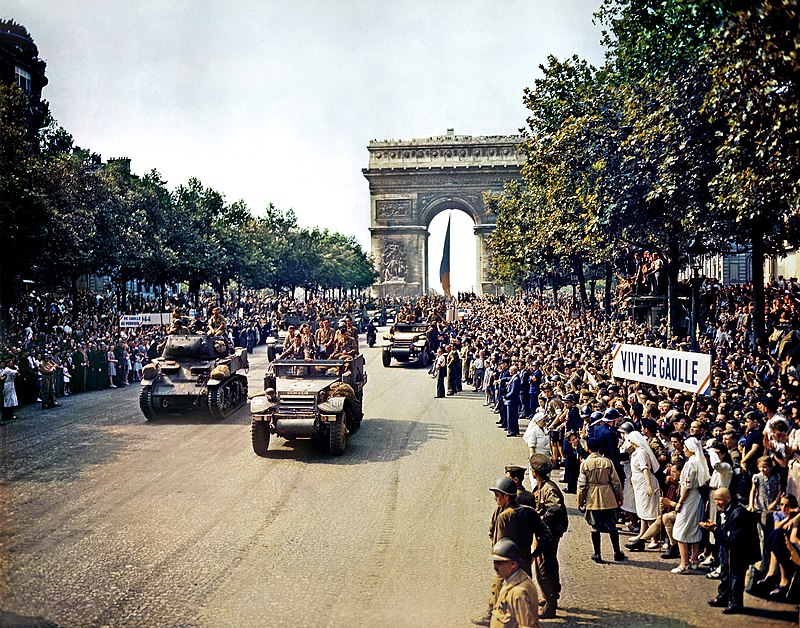
Front page of the New York Times on August 26, 1944, noting the liberation of Paris after Allied troops reached there, following D-Day.
On August 26, 1944, on a front page filled with other news from the war in Europe and the Pacific, the New York Times carried the story from the Associated Press:
Allied Forces Help French to Rid Capital of Nazis
By THE ASSOCIATED PRESS
SUPREME HEADQUARTERS, Allied Expeditionary Force, Aug. 25 — The Paris radio announced late tonight that the French capital had been liberated and that the German commander had signed a document ordering his troops to cease fire immediately.
The announcement followed entry of American and French troops into the capital during the day. There was no immediate confirmation here.
The latest word at headquarters was that American and French troops had joined Fighting French patriots on the Ile de la Cite in the heart of the capital after bitter fighting with Germans and French collaborationist militiamen.
Gen. Charles de Gaulle, President of the French Committee of National Liberation, said in a speech broadcast from Paris:
“France will take her place among the great nations which will organize the peace. We well not rest until we march, as we must, into enemy territory as conquerors.”
Allies invaded Europe at Normandy the previous June.

August, 1944: American soldiers watch as the Tricolor flies from the Eiffel Tower again. (Image: National Archives), via Brain Pickings
Wikipedia gives the unadorned, but detail-rich version of the story; note the vast array of national forces who joined to oust the Germans, including Spanish Republicans-in-exile:
The Liberation of Paris (also known as the Battle for Paris) was a military combat that took place during World War II from 19 August 1944 until the German garrison surrendered the French capital on 25 August 1944. Paris had been ruled by Nazi Germany since the signing of the Second Compiègne Armistice on 22 June 1940, after which the Wehrmachtoccupied northern and western France.
The liberation began when the French Forces of the Interior—the military structure of the French Resistance—staged an uprising against the German garrison upon the approach of the US Third Army, led by General George Patton. On the night of 24 August, elements of General Philippe Leclerc‘s 2nd French Armoured Division (the Régiment de marche du Tchad, a mechanised infantry unit led by Captain Raymond Dronne and composed primarily of exiled Spanish republicans), made its way into Paris and arrived at the Hôtel de Ville shortly before midnight. The next morning, 25 August, the bulk of the 2nd Armored Division and US 4th Infantry Division entered the city. Dietrich von Choltitz, commander of the German garrison and the military governor of Paris, surrendered to the French at the Hôtel Meurice, the newly established French headquarters, while General Charles de Gaulle arrived to assume control of the city as head of the Provisional Government of the French Republic.
Victory parades followed on August 26 and August 29. Paris was spared destruction ordered by German Chancellor Adolf Hitler when his commander simply failed to carry out the destruction, perhaps because his forces had been overrun more quickly than he’d imagined, perhaps because French underground and other resistance fighters simply prevented it.

From Wikipedia, a rare color photograph: “Crowds of French patriots line the Champs Elysees to view Free French tanks and half tracks of General Leclerc’s 2nd Armored Division passes through the Arc du Triomphe, after Paris was liberated on August 26, 1944. Among the crowd can be seen banners in support of Charles de Gaulle.” Jack Downey, U.S. Office of War Information – This image is available from the United States Library of Congress’s Prints and Photographs division under the digital ID fsac.1a55001.
More:
- Liberation of Paris, photos from AP available for sale (perhaps good for classroom use)
- “France Is Free: Anaïs Nin and Ernest Hemingway on the Liberation of Paris, August 19, 1944,” Brain Pickings, by Maria Popova



 Posted by Ed Darrell
Posted by Ed Darrell 







